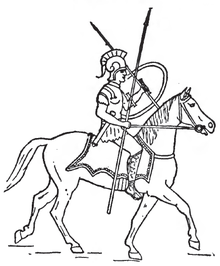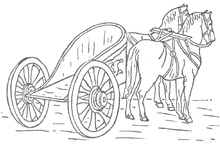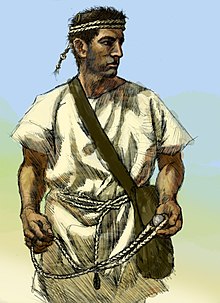Military of Carthage
These encounters influenced the development of the Carthaginians' weapons and tactics, causing Carthage to adopt the Greek-style hoplite soldier fighting in the phalanx formation.Carthage lacked a history of citizen infantry forces, requiring its army to be composed mainly of foreign troops, particularly Libyans, Numidians, Iberians, Gauls, and Greeks.[6] During the 4th century BC, the maximum number of standing troops Carthage expected at its service can be estimated from the capacity of the barracks located in the three rings of walls that protected the city, offering accommodation to 24,000 infantry, 4,000 cavalry, and 300 elephants.Beginning with the reign of King Hanno the Navigator in 480 BC, Carthage regularly began employing Iberian infantry and Balearic slingers to support Carthaginian spearmen in Sicily.After landing, Regulus' army immediately began scorched earth campaign, pillaging the Punic countryside and following a brief siege, sacking the city of Aspis.By seeking battles on open plains, Xanthippus was able to make the fullest use of Carthage's strengths, where Roman formations broke under attack from the elephant and cavalry charges.[11] In 247 BC, after eighteen years of fighting in the First Punic War, the Carthaginian Senate appointed Hamilcar Barca to assume command of Carthage's land and naval forces in the struggle against the Roman Republic.[15] As a result, Hamilcar was given a fairly small army and the Carthaginian fleet was gradually withdrawn so that, by 242 BC, Carthage had no ships to speak of in Sicily.Gallic and Ligurian footmen were armed with similar tall shields, chain mail, and bronze helmets, but carried heavier spears and longer, straighter swords.Their weapons and training were similar to those of the Greek hoplites: heavy spear, sword, aspis shield, and bronze greaves, helmet, and breastplate.[21] However, the polis Carthage was, over the course of several centuries, the dominant power in the Western Mediterranean and could establish its symmachy over large territories, which were also deeply influenced by the Punic culture.[22] The idea that mercantile business and warlike spirit are contradictory dates to the Age of Enlightenment[23] and is generally not shared by ancient sources, such as Virgil, who writes in Aeneid 1,444f.on Carthage: for this reason shall the people be glorious in war and acquire food easily for centuries (sic nam fore bello / egregiam et facilem victu per saecula gentem).Other sources can be interpreted to refer to a high degree of military professionalism in the small Punic population whose constitution Aristotle groups along with those of Sparta and Crete.An important part of the Punic culture seems to have consisted in their devotion to the gods, and their well-known units, called Sacred Bands by our Greek sources[specify], are regarded as the elite troops of their time.Fear had spread that this might be a Carthaginian trap to exterminate them without payment and save their silver, after having crippled their army of the specialized supportive arms units.The conditions for the payment were rejected, although their former commander, Gisco, had provided them with his own person and 500 other nobles as hostages to reassure them of Carthage's sincere and honest intentions.While both states were fundamentally governed by an elected body of noble citizens or "Senate"; one major systemic difference between the Roman Republic and the Carthaginian oligarchy was that their chief executives did not by virtue of office hold any direct authority over the military.The heavy infantry fought in close formation, armed with long spears and round shields, wearing helmets and linen cuirasses.It could be a Macedonian-style phalanx or some troops using long two handed naval lances, a practice quite common among marines at that age and according to Plutarch also successfully employed by the Romans.Numidia provided superb light cavalry, highly skilled in skirmishing tactics, armed with bundles of javelins, a small round shield and riding without bridle or saddle.Carthaginian forces also employed war-elephants, both within Africa and during overseas operations, including campaigns in Iberia and most famously Hannibal's invasion of Italy.In battle, the elephants functioned as a psychological weapon, frightening the opposing men and horses into flight or creating gaps in the enemy line that could be exploited by Carthaginian cavalry and infantry.[citation needed] The sailors and marines of the fleets were recruited from the lower classes of Carthage itself, meaning that the navy was manned in the majority by actual Carthaginian citizens, in contrast to the largely mercenary army.





Carthaginian EmpireGreek-Punic WarsPyrrhic WarPunic WarsHamilcar BarcaHannibal BarcaCarthageancient worldnorthern AfricaIberian PeninsulaSardiniaBalearic Islandscombined armsheavy infantrysiege enginesskirmishersheavy cavalrywar elephantschariotsSupreme commandSuffetesGreeksSicilyhoplitephalanxmilitaryRoman Republiclast of whichdestruction of the city of CarthageHannibalSecondLibyansNumidiansIberiansPhoenicianconscriptedCarthaginian cavalryMercenary WarMago I of CarthageMediterraneanmother cityEtruscansAppianAgathocles of SyracuseSicilian WarsHanno the NavigatorBalearic slingersLiguriansXanthippus of CarthageFirst Punic WarRoman ConsulMarcus Atilius RegulusBattle of Cape Ecnomussacking the city ofBattle of AdysSpartanXanthippusMacedonian armyPhillip IIlegionBattle of Bagradas RiverBattle of DrepanumGeorges RochegrosselinothoraxthureosSacred Band of CarthageAfricahoplitesgreavesDiodorussymmachyAge of EnlightenmentPoenulusMercenaries of the ancient Iberian PeninsulaPolybiusmercenariesLiguresSamnitesLucaniansStrategosthureophoroiNorth African elephantAfrican forest elephantAfrican bush elephantMarsala ShipCorvusIberian conquestSecond Punic WarThird Punic WarNumidian WarCarthage Punic PortsJustinThe Historiesloc. cit.
